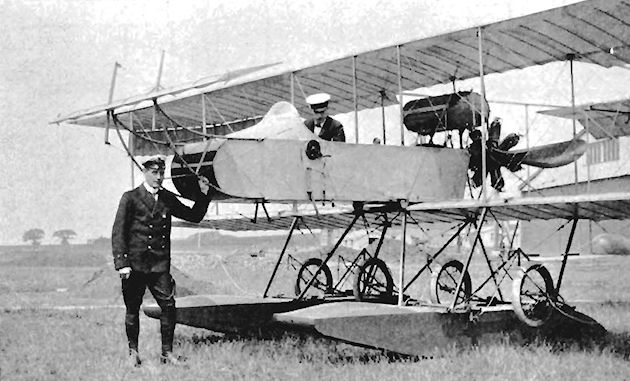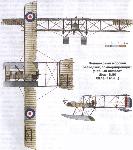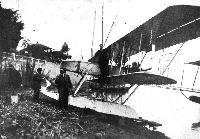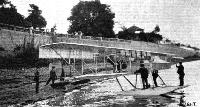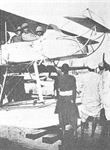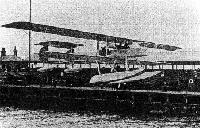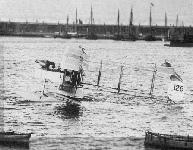А.Шепс Самолеты Первой мировой войны. Страны Антанты
Эта машина была развитием первого поплавкового самолета фирмы S.33, созданного на базе сухопутного самолета S.27 и более поздних машин S.35 и S.38 - учебных машин для британского флота. На базе этих машин и был создан двухпоплавковый трехстоечный полутораплан. Это был ферменный бесфюзеляжный самолет цельнодеревянной конструкции. Гондола имела деревянный каркас и фанерную обшивку и вмещала от 3 до 4 человек. В средней части гондолы устанавливались топливные баки, а в хвосте - силовая установка из двух 7-цилиндровых ротативных двигателей воздушного охлаждения "Гном-Моносупап" мощностью по 100 л. с., работающих на один винт. Крыло двухлонжеронное, цельнодеревянное, обтянутое полотном, причем верхнее крыло имело размах больший, чем нижнее, и соединялось кроме стоек еще и подкосами. Растяжки - стальной трос. Хвостовые параллельные фермы имели смешанную конструкцию из стальных труб и дерева. Оперение также имело деревянную конструкцию, аналогичную конструкции крыла. Стабилизатор устанавливался по верхнему поясу ферм, а рули поворота (2 шт.) навешивались на задние стойки ферм. В носовой части гондолы на выносных фермах устанавливался дополнительный руль высоты. Управление рулем осуществлялось через тросовые тяги от ручки управления и педалей. Элеронами оборудовалось только верхнее крыло. Элероны фармановского типа свободнопровисающие.
Главные поплавки понтонного типа имели деревянную конструкцию и крепились к гондоле шестью стойками и сложной системой растяжек. Хвостовые поплавки имели цилиндрическую форму и изготавливались из металла. Вооружение не устанавливалось.
Машина совершила первый полет 2 октября 1913 года, а 19 ноября - первый полет с тремя пассажирами. С началом войны командование ВМС планировало использовать S.80 как торпедоносец, но незначительная скорость и недостаточная грузоподъемность, а также отсутствие защитного вооружения не позволили применять самолет для этих целей. Поэтому S.80 использовался как учебный в течение 1914-1915 годов.
Показатель S.80 1913г.
Размеры, м:
длина 10,20
размах крыльев 21,49
Площадь крыла, м2 50,20
Вес, кг:
максимальный взлетный 1635
пустого 1000
Двигатель: "Гном-Моносупап"
число х мощность, л.с. 2x100
Скорость, км/ч 96
Экипаж, чел. 4
Вооружение 335-мм торпеда
Показать полностью
C.Barnes Short Aircraft since 1900 (Putnam)
Short Pusher Biplanes (1910-14)
<...>
Early in 1913 Frank McClean and an explorer, J. H. Spottiswoode, decided to organise a seaplane expedition up the River Nile to see the Aswan Dam and investigate the cataracts between there and Khartoum. Realising that high power and low wing-loading were essential for take-off in the hot Sudanese climate, McClean had his old school biplane S.32 rebuilt to the S.38-type standard, but with an extra bay inserted on each side in both upper and lower wings, increasing the span to 70 ft 6 in; the extra bay and overhung extension formed a single unit, with dihedral and taper on both upper and lower wings. This machine, though intended as a seaplane ultimately, was first flown at Eastchurch in May 1913 as a landplane, using its original two-wheeled crossaxle undercarriage and a 70 hp Gnome engine; it seems to have incorporated components discarded from other early biplanes, including S.33 and S.34, which has confused its provenance, but it evidently contained more parts from S.32 than from elsewhere. With a wing-loading of little more than 2 Ib/sq ft, it flew easily but was very slow and could make no headway against any appreciable wind, so it was obviously unfit for development, even with twice the power; furthermore, its tandem nacelle provided too little stowage space for the expedition’s needs. So McClean ordered a new seaplane specially designed for the purpose, with a wide nacelle having two pairs of seats side-by-side; this was the Nile Seaplane, S.80. It had constant-chord wings of 67 ft span, 5 ft chord and 5 ft 3 in gap, with strut-braced extensions, parallel ailerons and folding gear; to clear the uprights in the tail-boom structure when folded, the upper wings had small hinged flaps in the trailing edge resembling inset ailerons. The two-row 160 hp Gnome engine drove a massive two-bladed propeller, and the two main pontoon floats were carried on three pairs of struts beneath the nacelle; twin air-bags were attached under the lower tail-booms, and these were far enough apart to render wing-tip floats unnecessary for lateral stability on the water.
S.80 was first flown as a seaplane at Leysdown on 2 October, 1913, by Gordon Bell; on 19 November, with Frank McClean as pilot, it proved its weight-lifting ability by taking off from Harty Ferry with Alec Ogilvie, Horace Short, Charles Samson and Ivor Courtney as passengers. McClean asked Samson to be his co-pilot on the Nile venture so as to have at least one Gnome expert in the crew, but Samson could not get leave, and Ogilvie took his place. S.80 was shipped to Alexandria in the Corsican Prince; it arrived on 27 December and was re-erected at the Naval Dockyard by McClean, Ogilvie and Horace Short and their mechanic Gus Smith, assisted by Anna McClean, who had charge of the party’s domestic affairs. On 2 January, 1914, the seaplane was launched by being carried bodily into the water by a gang of Dockyard workers, and next day McClean, Ogilvie, Horace Short and Smith flew the 160 miles to Cairo in just under three hours, but this was the limit of its range, and Spottiswoode had to lay down fuel dumps at 120-mile intervals all along the route, which fortunately kept close to the railway except for the gap between Wadi Haifa and Aswan. After a few days the party started off again, but soon began to have trouble with overheating of the rear bank of cylinders, and after take-off from the Aswan Dam the performance fell off so quickly in the first 40 miles that McClean returned to the Dam, mostly on the water, and the engine was found to require four new cylinders; these were cabled for from Paris, and a fresh start was made on 16 February, when the seaplane flew 192 miles up-river to Wadi Haifa, on the Sudan frontier. From there McClean had been recommended to follow the railway direct across the desert to Abu Hamed, substituting wheels for floats, but he preferred to stay with the river round the Dongola Bend in order to see the second, third and fourth cataracts. After two days’ rest the seaplane was flown, with two refuelling stops, 245 miles to Argo, where McClean found they were being pursued by a gigantic ‘haboob’ and had to alight abruptly, breaking off the port lower wing-tip. This was patched up and the flight continued to Merowe, where the Governor of Dongola Province, Col Jackson, entertained the party in royal style; after several more stops with minor engine trouble they reached Abu Hamed, but an hour (45 miles) later an oil pump broke and they had to come down on the rock-strewn river and taxi three miles to Shereik, where they beached and encamped till a spare pump could be sent from Atbara by rail to Shereik station, six miles away. Next day they had flown for only an hour when both oil pumps failed together, and in the ensuing ‘dead-stick’ landing one float and two of its struts were damaged; local tribesmen beached the machine near Gananita Island, with a station only three miles away, and the Sudan Railway sent a wagon-load of spares from Atbara, together with a carpenter and a mechanic. After ten days the engine had been rebuilt and damage to the floats and tail-booms repaired; they left Gananita on 14 March and arrived at Atbara in under an hour, but next day, after flying a similar distance to Kabushia, a connecting-rod broke and wrecked the engine, which had to be taken out yet again and sent back to the railway workshops at Atbara. On 22 March they took off once more, and this time, with the help of a strong tailwind, reached Khartoum in under two hours; after a day giving joy-rides at Khartoum S.80 was dismantled and crated for return to England via Port Sudan and the Suez Canal, somewhat to the relief of all concerned.
At Eastchurch it was found that the centreplane top rear spar was fractured, so the seaplane was extensively rebuilt, with new wings, new tail-booms slightly convergent in plan (bringing the rudders closer together) and a new tailplane of reduced chord. The front elevator (which McClean agreed did no useful work but was there ‘for company’ at his request) was removed and the nacelle was revised to a dual-control Sociable layout, with the fuel tank lowered into the space formerly occupied by the two rear seats. There was a proposal to adapt S.80 as a torpedo-carrier for H.M.S. Hermes, but this plan was dropped; McClean flew it again for the first time at Harty Ferry on 13 July, and later made several trips with passengers to Westgate and back. Finally, when war was seen to be imminent, he flew it across to the Isle of Grain on 1 August as a gift to the Admiralty, and four days later was himself gazetted in the R.N.A.S. as a Flight Lieutenant, afterwards commanding the Naval Flying School at Eastchurch. In October 1914, S.80 was re-engined with a more reliable 100 hp Gnome-Monosoupape driving a four-bladed propeller, also acquiring a central rectangular fixed fin and larger rudders; it carried early Naval red circles on the wings but no other markings, although the serial 905 was allotted. It remained at Grain in 1915, but could not take off from calm water in zero wind with its lower-powered engine, so it was only used for seaplane practice by aeroplane pilots. McClean also presented his 70 hp wide-span S.32 to the Admiralty; this became 904 in the R.N.A.S., and after being rebuilt with standard 52-ft-span wings and double landing wheels was used as a trainer at Hendon.
Short Brothers’ final pusher design was a twin-float seaplane, S.81, generally similar to S.80, but with rubber-sprung floats (introduced by Oswald Short) and a strengthened nacelle designed by the armament specialist Arthur Camden Pratt to mount a 1 1/2-pounder Vickers shell-firing gun. It was a logical development of the Maxim-armed 66 and was ordered specifically for aerial gunnery trials at Calshot by Lieut Clark-Hall. S.81 had a 160 hp Gnome and four-bladed propeller, also wing-tip floats were provided because the raised centre of gravity due to the gun increased the tendency to roll while moored out or taxying. S.81 was first flown in the spring of 1914 at Calshot; the gunnery trials were not very successful, and the gun was later passed to the R.F.C. for testing over land, but S.81 received the Naval serial 126 and took part in the Spithead Naval Review in July. Later it was sent to Great Yarmouth, where in March 1915 it was equipped with a 6-pounder Davis recoilless gun, with which scheduled trials were successfully completed in April, but this unwieldy weapon was not adopted for active service, being outclassed by the advent of synchronised machine-guns which could more effectively be installed in high-performance tractor biplanes. Although S.81 was the last pusher biplane built by Short Brothers, the S.38-type dual-control school biplane was produced by sub-contractors throughout 1914 and 1915, 12 being built by Pemberton-Billing Ltd at the Supermarine works at Woolston, Southampton, and 24 by White & Thompson Ltd and their successors The Norman Thompson Flight Co Ltd at Middleton-on-Sea, Bognor, Sussex; the last were delivered in June 1916, and all were flown at the Eastchurch and Chingford Naval Flying Schools until superseded by Avro 504s.
S.80-81 - Span 67 ft (20-4 m); length 33 ft 9 in (10-2 m); area 540 sq ft (50-2 m2); empty weight 2,200 lb (1,000 kg); loaded weight 3,600 lb (1,635 kg); speed 60 mph (96-6 km/h).
Показать полностью
M.Goodall, A.Tagg British Aircraft before the Great War (Schiffer)
Deleted by request of (c)Schiffer Publishing
S80. Pusher biplane, the Nile seaplane
In 1913 F.K. McClean planned an aerial exploration of the Rivet-Nile, for which S32 was originally intended, but this aircraft proved to be inadequate for the purpose and a new seaplane was built. This was S80 (McClean No. 16), which flew for the first time as a seaplane on 2 October 1913, piloted by Gordon Bell and although basically a four seater, it was soon flown with five aboard. The aircraft arrived in Egypt on 27 December 1913 and was flown from Alexandria to Khartoum by stages, suffering some damage and repairs en route. It was dismantled at Khartoum and returned to England in March 1914. At Eastchurch major repairs and modifications were carried out, including conversion to a two-seater side-by-side layout.
As originally built, S80 was a typical Short pusher biplane with a nacelle and with a front elevator on an outrigger on the nose. There were the usual tailplane and elevator carried on top of the tail booms, which were parallel in plan and elevation. Twin balanced rudders were fitted. The two bay wings carried top wing extensions braced by struts and wires with single acting ailerons on the top wings only. The main floats, parallel in width, tapered to a curved stern and were each mounted by three struts. The tail was supported by two air bags of circular section below the tail booms.
During the rebuild, on return to Eastchurch, the fuel tanks were lowered into the compartment previously housing the rear seats, and the front elevator was removed. In this form McClean presented the machine to the Navy in August 1914, when it was identified as No.905, although never marked as such. In October the original 160hp Gnome was replaced by one of 100hp. A large rectangular fin was mounted with most of the area above the tailplane. The tail booms were tapered inwards towards the tail bringing the rudders, which were of a new shape, closer together.
Power: 160hp Gnome fourteen-cylinder two-row air-cooled rotary. Replaced later by 100hp Gnome Monosoupape nine-cylinder air-cooled rotary with a four-bladed propeller.
Data
Span 67ft
Area 540ft
Length 33ft 9in
Weight 2,200 lb.
Weight allup 3,600lb.
Speed 60 mph
S81. Pusher biplane. Gun carrying seaplane
A machine generally similar to S80 was constructed for the Admiralty for aerial gunnery experiments, and was first flown at Calshot in May/June 1914. Tests of the Vickers one and a half pounder, Lewis machine gun and Davis six pounder guns were carried out at various times, also tests of a dynamo and searchlight, before the machine, No.126, was discarded in October 1915.
Variations from S80 included rubber sprung floats and wingtip air bags. This machine was the last pusher design to be produced by Shorts.
Power: 160hp Gnome fourteen-cylinder two-row air-cooled rotary with a four-bladed propeller.
Data As for S80
Показать полностью
P.Lewis The British Fighter since 1912 (Putnam)
By the same year, Short Brothers had become a firmly-established company with a number of extremely successful practical designs to their credit and had already begun to specialize in floatplanes, a type of machine in which they rapidly excelled and for which they were justifiably widely known. Among their products for 1913 was the S.81 Gun-carrier, designed for them by A. Camden Pratt specifically to carry out tests of armament. The machine was destined to be the final pusher Short floatplane and was a three-bay biplane, the wings of which folded. No.126 was a fairly large machine and was supported on the water by twin main and tail floats, augmented by one under each lower wingtip. A 160 h.p. Gnome provided the power at the rear of a nacelle which had to be particularly strong to stand up against the tremendous recoil of the quick-firing Vickers 1-5-pounder gun, for the thorough testing of which the S.81 had been ordered from Short Brothers.
These trials had been instituted by the Naval Wing of the R.F.C. on 29th July, 1913, when Lt. R. H. Clark-Hall, a naval gunnery officer, had been given the job of supervising the assessment of suitable armament for naval aeroplanes. First intentions were that the Vickers 1-5-pounder received by the Navy was to be installed in the Astra Torres airship and then in a Sopwith Gunbus but the big gun finally found a home in the S.81, only one of which was built. The Gun-carrier carried out its allotted task for some two years, being used in early 1915 as a vehicle for the testing of the recoilless 6-pounder Davis gun.
Показать полностью
F.Mason The British Fighter since 1912 (Putnam)
Short S.81 Gun Carrier
It would be anomalous to omit an entry in this work covering the Short S.81 Gun Carrier, although it is difficult to imagine this large seaplane as a fighter in any accepted sense. It was in fact the last variation in a series of single-engine pusher biplanes which had started life in 1910 as the S.27 Type, and progressed by way of such aircraft as the S.33, S.38, S.62 and S.80, and which had appeared in either land- or seaplane guise. The S.80 had been produced with both wheel and float undercarriage, and the S.81 was an immediate derivative ordered specifically to undergo air gunnery trials with a 1 1/2-pounder Vickers shell-firing gun.
Unlike most other companies’ single-engine pusher biplanes, the Short S.81’s tail booms did not converge to a single sternpost and rudder, but were rigged in parallel both in plan and elevation, each terminating in a sternpost and each supporting a balanced rudder without fixed fin, as well as a cylindrical tail float. The relatively short main floats were rubber sprung (an innovation introduced by Oswald Short) and small cylindrical stabilizing floats were mounted under the lower wingtips.
Power was provided by a 160hp Gnome two-row engine driving a four-blade pusher propeller, the top wing centresection being cut away to provide blade clearance. The reinforced nacelle itself was shortened to no more than five feet and mounted the 1 1/2-pounder gun on a superstructure in the nose; the gunner’s cockpit was located on the port side of the gun’s breech.
Designed by Arthur Camden Pratt, the sole Short S.81, Admiralty No 126, was first flown in about April 1914 at Calshot where Lieut R H Clark-Hill rn flew the gunnery trials. It is said that, when the Vickers gun was fired, the recoil was so severe that the aircraft stalled and dropped 500 feet. Needless to say, the trials were not considered to be a success, and the gun was then passed to the RFC. Further trials with another gun, the recoilless six-pounder Davis, were flown at RNAS Great Yarmouth in March and April 1915. However, with experiments imminent to develop gun synchronizing mechanisms, the gun-carrying pushers’ days were numbered, and the Short S.81 disappeared from the scene.
Type: Single pusher engine, two-seat, twin-float, three-bay biplane gun carrier.
Manufacturer: Short Bros, Eastchurch, Isle of Sheppey, Kent.
Powerplant: One 160hp Gnome two-row engine driving four-blade pusher propeller.
Structure: Light-gauge steel tubular construction with fabric and duralumin covering; twin main float undercarriage with twin wingtip stabilizing floats and twin tail floats. Ailerons on upper wings only.
Dimensions: Span, 67ft 0in; wing area, 540 sq ft.
Weights: Tare, 2,200lb; all-up: 3,600lb.
Performance: Max speed, 60 mph at sea level.
Armament: One 1 1/2-pdr Vickers gun with special mounting on nose of nacelle.
Prototype: One, No.126 (first flown in about April 1914 at Calshot). No production.
Показать полностью
P.Lewis British Aircraft 1809-1914 (Putnam)
Short S.70
In 1913 F. K. McClean decided to attempt a tour of Egypt by air by using a seaplane to be flown along the River Nile, and Horace Short was asked to design the machine. In appearance, it was reminiscent of the S.38, but the span of the wings was increased to 70 ft. 6 ins., making it, in this respect, the largest successful aeroplane built in the United Kingdom before the 1914-18 War. Three and a half bays were used in the wings, the upper tip extensions of which were braced by struts, an unusual feature being the provision of small additional ailerons set between the centre section and the main ailerons. These main ailerons were of considerable length and extended from mid-way of the upper span to the tips. The nose of the nacelle carried a small elevator mounted on outriggers as an auxiliary to that hinged to the rear of the tailplane. The engine fitted at the back of the nacelle was the 160 h.p. Gnome, the most powerful version available.
The S.70 was finished towards the end of the year and was tested at Eastchurch with a land undercarriage. On 19th November, 1913, although built as a three-seater, it took off from the same aerodrome in the course of its proving flights with five passengers - Lt. I. T. Courtney. R.N., F. K. McClean, Alec Ogilvie, Cdr. C. R. Samson, R.N., and Horace Short. The machine was then dismantled and packed for transporting by ship to Alexandria, where it was reassembled for the expedition. Frank McClean was accompanied by Alec Ogilvie as additional pilot and by A. Smith, who was the mechanic. The floats for the Nile landings consisted of a large pair at the front of the S.70 and two more fitted at the rear under the tail side-by-side.
The trip up the Nile started on 3rd January, 1914, Cairo being reached in 2 hrs. 55 mins. Unfortunately, the engine subsequently gave considerable trouble and the floats were damaged on several occasions. The tourists pressed on with their flight and reached Khartoum on 23rd March, having covered about 1,400 miles. They then decided that they had travelled far enough, and the S.70 was accordingly taken to pieces and returned home to England with its crew by ship.
SPECIFICATION
Description: Three-seat pusher hydro-biplane. Wooden structure, fabric covered.
Manufacturers: Short Brothers, Eastchurch, Isle of Sheppey, Kent.
Power Plant: 160 h.p. Gnome
Dimensions: Span, 70 ft. 6 ins. Length 35 ft. 6 ins. Wing area, 725 sq. ft.
Weights: Empty, 1,050 lb.
Performance: Maximum speed, 58 m.p.h. Endurance, 5 hrs.
Short S.81 Gun-carrier
The S.81 Gun-carrier was designed by A. Camden Pratt and built by Short Brothers during 1913. The machine was a two-seat hydro-biplane developed specially for experiments with armament, and was the last Short pusher floatplane. Three-bay folding wings were fitted, with extensions on the upper planes braced by struts. Twin floats were used at the front and also at the tail. The nacelle was strong enough to withstand the recoil of the Vickers 1-5-pounder gun with which it was tested at Great Yarmouth "Naval Air Station. During 1915 the Davis 6-pounder gun was mounted for trials in the S.81. The sole example constructed was numbered 126, and was powered by the 160 h.p. Gnome.
Показать полностью
J.Bruce British Aeroplanes 1914-1918 (Putnam)
Short S.81 Gun-carrier
EXPERIMENTS with aircraft armament in the Naval Wing of the R.F.C. were put on an official footing on July 29th, 1913. On that date Lieutenant R. H. Clark-Hall, R.N., was placed in charge of the work. By the end of 1913 three semi-automatic guns had been ordered and issued for practical tests which were to be conducted by both the Naval and Military Wings.
The first of these three experimental weapons was a 1 1/2-pounder Vickers gun which was delivered to the Navy. It was intended to mount this gun first in the Navy’s Astra Torres airship and later in a Sopwith Gun Bus.
Ultimately, however, a special seaplane was ordered from Short Brothers to enable the gun to be tested properly. The machine had the Short works number S.81, and was designed by A. Camden Pratt. It was a large pusher float seaplane, powered by a 160 h.p. Gnome engine. The wings had three bays of struts, and there were long extensions on the upper mainplanes, braced in the same way as those of the enlarged Folder tractor floatplane. Ailerons, which had no balance cables, were fitted to the upper wings only.
The nacelle was conventional in appearance, but its design presented some problems in stressing for the recoil of a semi-movable quick-firing gun. The tail-unit resembled that of the Short S.38; and the undercarriage consisted of two main floats and two tail-floats. A small float was fitted under each wingtip.
It has been said that when the Vickers gun was fired the force of the recoil was so great that the S.81 stopped dead and dropped 500 feet. Be that as it may, the S.81 is next heard of at the R.N.A.S. Station, Great Yarmouth, early in 1915. There it was again used to test a heavy weapon: in March and April, 1915, experiments were carried out with a 6-pounder Davis gun fitted to the S.81. The recoil difficulty did not arise in the case of the Davis gun, however, for it was a double-ended affair which fired a blank charge rearwards at the same time as it fired its projectile.
Whatever the outcome of these experiments, the Short S.81, or Gun-carrier as it was popularly called, vanished from the R.N.A.S. scene.
SPECIFICATION
Manufacturers: Short Brothers, Eastchurch, Isle of Sheppey.
Power: 160 h.p. Gnome.
Armament: One 1 1/2-pounder Vickers semi-automatic gun, mounted on the nose of the nacelle; later one 6-pounder Davis gun was fitted.
Service Use: R.N.A.S. Station, Great Yarmouth.
Serial Number: 126.
Показать полностью
H.King Armament of British Aircraft (Putnam)
S.81 Gun-carrier. A pusher seaplane of this description (No. 126) was built in 1914 with a specially stressed nacelle for the mounting and firing of a 1 1/2-pounder Vickers gun. This development was preceded by the mounting of the gun on the Sopwith pusher seaplane No.127. It was reported in 1914 that 'excellent practice has been done in firing at targets both in the air and on the sea'. During March 1915, a 6-pounder Davis recoilless gun was tested in the same machine.
Показать полностью
Журнал Flight
Flight, January 10, 1914.
Mr. McClean Starts.
The first stage of Mr. F. K. McClean's trip up the Nile to Khartoum was made on Saturday last, when accompanied by two passeneers Mr. McClean piloted the 160 h.p. Short waterplane from Alexandria to Cairo, the distance of about 160 miles taking 2 hrs. 55 mins. Restarting from Cairo on Tuesday morning, with three passengers on board, the machine had to battle with the wind and eventually a stop was made at Minieh.
Flight, January 24, 1914.
Mr. Frank McCIean's Progress along the Nile.
ON the 16th inst. Mr. McClean arrived on his Short waterplane at Luxor, and later went on to Assuan, while two days later he made some nights to the delight of the great crowd which had gathered to see the machine. On Monday he started to continue his flight south to Khartoum, but after flying about 130 miles had to return to Assuan, owing to trouble with the motor. He has had very bad luck with his motor, and had to spend several days at Assiut on account of a broken ball race which distributed itself in the crankcase.
Показать полностью
